Read this article in French German Italian Portuguese Spanish
Globalisation to regionalisation? LiuGong’s new management readies for a changing world
23 July 2025
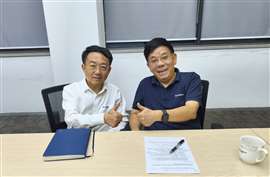 LiuGong's new president and vice chairman Luo Guobing (left) with former CEO and chairman and current consultant Zeng Guang'an (Image courtesy of LiuGong)
LiuGong's new president and vice chairman Luo Guobing (left) with former CEO and chairman and current consultant Zeng Guang'an (Image courtesy of LiuGong)
Once a modest regional player offering a limited range of wheel loaders, LiuGong has grown into one of China’s most formidable names in construction equipment manufacturing.
Headquartered in Liuzhou, the company now produces a full spectrum of machinery - from excavators and dozers, to mining trucks, cranes, and aerial platforms, serving 180 different countries outside of its home market of China.
Over the past decade, LiuGong’s revenue has more than doubled, from US$1.7bn in 2015 to US$4.2bn, ranking 18th in the latest Yellow Table.
That rise has been shaped by the leadership of Zeng Guang’an, who has worked for LiuGong for 40 years and became president 25 years ago, in 1999.
But a significant transition is afoot at LiuGong. Mr. Zeng announced that he would retire as chairman and CEO in May this year, as he reaches the age of 60. His successor, Luo Guobing, who joined LiuGong in 1994, now steps into the role of president and vice chairman.
Both Zeng and Luo spoke exclusively to Construction Briefing/International Construction about LiuGong’s global ambitions and how it plans to navigate the challenges of a changing world.
Readying for a changing landscape
Looking back over the last ten years, Mr. Zeng notes that there have already been some significant changes in the global construction equipment industry.
The first of this is the meteoric rise of Chinese manufacturers, both in China’s domestic market and overseas. “Before, there were three main groups of manufacturers – North American, European, and Japanese/Korean. But today, China makes up a fourth group that is growing very fast, with good quality machines and new technology,” he asserts.
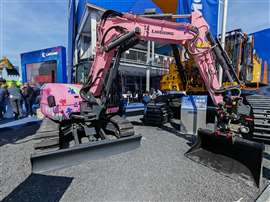 LiuGong’s 909ECR mini excavator stood out at Bauma 2025 thanks to a pink Bauhinia blossom decal – a tribute to the Chinese OEM’s hometown of Liuzhou, Guangxi province (Image: Neil Gerrard)
LiuGong’s 909ECR mini excavator stood out at Bauma 2025 thanks to a pink Bauhinia blossom decal – a tribute to the Chinese OEM’s hometown of Liuzhou, Guangxi province (Image: Neil Gerrard)
Those domestic manufacturers have come to dominate China’s market, as they weathered the cycles of boom and bust there more effectively than international rivals, he says. Chinese manufacturers now account for 90% of the domestic excavator market, he points out by way of example.
Nonetheless, China remains, in his view, a very open market, where many of the world’s biggest OEMs still have a presence. “China is also the country that is most adaptable to new technology,” he adds. “For example, there is a big market for electric machines in China, and also autonomous and smart solutions. Chinese customers are very sensitive to new technologies.”
In fact, according to Off Highway Research, China accounts for 80% of the entire global market for electrically driven construction equipment.
And more change is coming. Whereas in the past, lower trade barriers meant high levels of internationalisation for OEMs, the environment over the next five to ten years could be significantly different.
“Every government is starting to focus on the regional,” says Mr. Zeng. “The US is fighting with every country and has increased tariffs, they have the anti-dumping policies. So the market will change. In Europe, there is something similar in terms of actions against other countries’ manufacturers. The emerging markets are not as stable as Europe and North America but markets like India will keep growing. I think this will have a lot of influence on our industry.”
But the coming changes do not mean that LiuGong will be turning its back on international markets: quite the contrary. Instead, Mr. Luo wants to set the conditions for the business to be more adaptable and agile and to do so will enlist the support of Mr. Zeng, who will remain as a senior consultant to the company.
Mr. Luo notes that on his predecessor’s watch, LiuGong was one of the first Chinese construction equipment OEMs to start doing business internationally. Overseas sales now make up 52% of LiuGong’s total revenue.
For Mr. Luo, one of LiuGong’s priorities is to grow the share of international revenue even further, with a target of 60%. To achieve that, he emphasises strong customer support, brand trust, localised production and service, and improved product quality.
Mature vs. emerging markets
Mr. Luo continues to regard mature markets like North America and Europe as important. “When we talk about total values, they are very big markets and should be part of our business. The mature markets also have a requirement for a high standard of technology, that can help us keep growing,” he says.
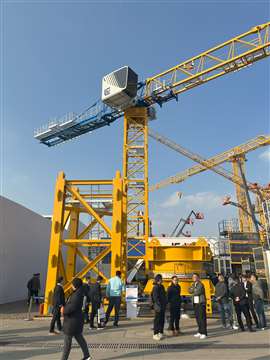 LiuGong’s PT7025A-12 mid-range flat top. The company has added cranes to its product line-up through acquisition. (Photo: Alex Dahm/KHL Group)
LiuGong’s PT7025A-12 mid-range flat top. The company has added cranes to its product line-up through acquisition. (Photo: Alex Dahm/KHL Group)
Profit margins on machines sold in these markets are higher than in emerging markets, he notes, and success there can also help to persuade customers in other markets to buy LiuGong’s machines. During Bauma in Germany this year, the company announced that it was opening regional hubs in Italy, France, and Germany this year, to embed localised research and development teams, as well as strengthening customer support.
There are promising opportunities coming up in some emerging markets too, he notes, including India, the Asia Pacific region, and Africa.
India exemplifies LiuGong’s globalisation via local resources. It already has one factory there and is building another, due in late 2025 or early 2026.
“LiuGong will speed up the R&D overseas, as well as manufacturing and marketing and sales. And we will have some capital support to do that,” says Mr. Luo.
“It is very important to use local suppliers and local talent. Currently, 24% of our people are from outside of China. I think that will increase to 40%,” he adds.
In India, for example, the company employs 1,000 people but just seven of those are from China. Mr. Luo met with representatives of the Indian government earlier this year and notes that there is strong support for Chinese investment in the country. “We are training a lot of skilled people and have very good cooperation with the government. Of course, we have provided a lot of tax to support the country’s development too.”
Mining a target for the next decade
Mining remains another of the company’s target businesses, and with continued demand for raw materials like gold and copper, as well as for energy, Mr. Luo is optimistic about prospects in the sector for the next ten years.
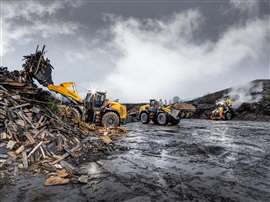 LiuGong unveiled its T-Series wheel loaders at Bauma in Munich, Germany (Image: LiuGong)
LiuGong unveiled its T-Series wheel loaders at Bauma in Munich, Germany (Image: LiuGong)
“LiuGong was the first company to launch heavy electric machines to the market. This has been very successful in China and also in some mature markets like northern Europe and North America,” he says. He highlights the environmental credentials of electric machines, as well as the fact that the total cost of ownership (TCO) for the machines is attractive. Semi-autonomous and autonomous machines are also becoming more popular in the segment, he notes.
More products for the mining sector are also on the way. Mr. Zeng says that, in addition to LiuGong’s rigid trucks and wide-bodied trucks, it will soon launch articulated trucks too.
“Mining equipment is a difficult product group but we already have a good foundation and I think Mr. Luo will continue this strategy to become a leading manufacturer in the next ten years,” says Mr. Zeng.
Investing in R&D
Mr. Zeng places a strong emphasis on the research and development (R&D) of innovative products and technology. Earlier this year, he highlighted the fact that the company has increased its R&D spending from 3.5% of revenue to 4% over the past four years.
“We have world-class R&D facilities – we spend lots of money on them. These are not only in China – we also have international R&D centres,” he says. He acknowledges the support of David Beatenbough, former director of construction equipment for Asia Pacific (Engineering) at Case, who has worked for LiuGong for 15 years as a vice president and another five years as a consultant.
“We started from low levels compared to European, Japanese, and American manufacturing 20–25 years ago,” says Mr. Zeng. “But in the last ten years, we spent a lot to invest in intelligent autonomous manufacturing systems, especially for the big wheel loaders and excavators, and some components.”
That has led to higher quality products and faster delivery, as well as a tighter control on costs, he asserts.
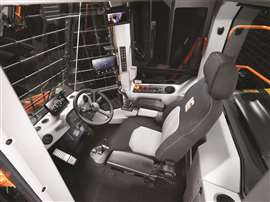
Another important aspect is the collaborative work LiuGong has done with its supply chain. It has joint ventures with component firms like Germany’s ZF for drivetrains and US-based Cummins for engines, as well as a strategic partnership with hydraulics specialist Rexroth. “These joint ventures are very important. They don’t only provide for LiuGong, they provide for the industry,” Mr. Zeng says.
Meanwhile, the company has already launched electric machines in about 50 countries. Mr. Luo launched a global promotional drive, culminating at Bauma. “I think we have played a major role in changing the world’s industrial technology. We have good cooperation with components suppliers to build a worldwide component system for electric equipment,” says Mr. Zeng.
He continues, “LiuGong will accelerate the new technology development, especially for electric systems. We almost have a full range of electric machines. There is a package to support the customers already, but still we need some final developments to create more advantages for the electric machine technology and intelligent products.”
And if LiuGong already regards itself as a leader in electric machines, that’s no reason for complacency, according to Mr. Zeng. “If we think, ‘Oh, we are the leaders in electrification technology’, then maybe next year, you will fail. So we have to keep investing, keep moving fast, and have more innovation in these areas to keep LiuGong as the leader in the global market,” he asserts.
Another important area of focus for the company is on semi-automated and automated machines. “I am actually very optimistic about the automation and the semi-automation of products and technology,” says Mr. Luo.
“This is the future not only because the technology is advancing but because it is connected to the labour shortage and can offer safety and efficiency improvements. There is a lot of cost pressure, especially for high labour cost countries, so this will support its development.”
He admits that fully automated products can currently only be used for very specific applications and situations but further development is likely to see intelligent products and systems proliferate.
China’s market bottoming out?
At home, LiuGong is starting to see signs that the construction equipment market in China is bottoming out after several difficult years and could eventually be on a path to moderate growth.
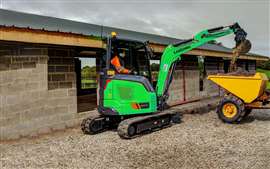 Liugong 9027FE electric excavator (Image: Liugong)
Liugong 9027FE electric excavator (Image: Liugong)
That will be helped in part by the rising cost of labour. “Machines, especially small machines, are a very effective way of reducing the labour requirement,” says Mr. Luo. “This year, the demand for mini excavators and other smaller machines has been very good. I think this kind of situation will keep going.”
Competition between manufacturers in the country has been tough in recent years, he notes. “Some companies are doing very well. Some have problems. I think companies that have the global rollout like LiuGong will get better. At the same time, those who depend on the Chinese market will have some problems.”
That creates the potential for acquisitions and Mr. Luo is open to the idea but only under the right circumstances. “We have the plan to acquire or cooperate with some companies. But it should be a good company and match our strategy requirement. We have enough production capacity, so this is not our target company to acquire.”
Construction’s ever-evolving future
Over the coming three to five years, Mr. Luo expects the industry to enjoy moderate growth of 3-5% per year.
But its structure will change, he predicts. Emerging markets like India, Latin America, parts of Africa, and the Asia-Pacific region will become a more important part of the mix.
In mature markets, sales are expected to start increasing as customers begin replacing machines that they held off investing in. He also anticipates healthy demand in mining products in markets like Africa, India, China and North America.
Customers’ expectations are also changing – they increasingly expect intelligent solutions and full lifecycle support..
Mr. Zeng agrees and adds that it’s also important for the company to invest in the next generation.
“If we cannot invest in people and especially the younger generation, we have no future. We have good people, a good culture, and strong core values. These will support Mr. Luo and the younger generation to keep growing the business and become even more successful,” he concludes.
STAY CONNECTED



Receive the information you need when you need it through our world-leading magazines, newsletters and daily briefings.
CONNECT WITH THE TEAM







